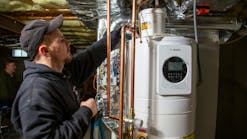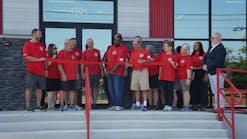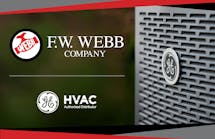The North American HVACR market is relatively new territory for Daikin, a worldwide manufacturer of home comfort systems, but the company is making great strides here by focusing on advanced technology that delivers greater comfort to consumers. With a particular emphasis on its ductless mini-split systems' variable-speed technology, the manufacturer is creating partnerships with distributors and contractors to build the Daikin brand.
“To bring this premier company and global player in the HVACR industry here is very exciting,” says Russell J. Tavolacci, director of product marketing for Daikin AC (Americas), the North American brand of Daikin. In less than two years, Japan's Daikin AC, headquartered in Carrollton, TX, has already made inroads throughout the United States by demonstrating that technologically superior comfort systems, when backed up by training, education and service, really make a difference for everyone throughout the supply chain, right down to the consumer.
For the end-user, Daikin products mean a noticeable difference in their overall comfort. Tavolacci cites two recent examples of a homeowner in Massachusetts who had a Daikin ductless split system installed in his home and a contractor in Rhode Island who installed a larger commercial system. Each described, in nearly identical terms, how well the Daikin systems performed. The homeowner said he had “never had such a comfortable and balanced temperature throughout the home” while the contractor in Rhode Island said the balanced temperature was “remarkable, something I've never seen before.” Says Tavolacci of the Daikin technology: “You have a system that's doing all the work to vary the speed and vary the inner workings of the system to have constant comfort. That's the essence of our system.”
As a manufacturer of systems with advanced technology, such as its VRV-S® (Variable Refrigerant Volume) and split air conditioning systems, Daikin AC relies on traditional, on-the-ground techniques to connect with distributors and contractors who will ultimately sell and install the Daikin systems. Sales and marketing assistance, training and education, and plenty of ongoing, continuous interaction with Daikin representatives are creating what Daikin AC expects will be long-lasting relationships with distributors and contractors.
For HVACR distributors, it makes sense to be associated with premium ductless systems, says Malcom Sanford, national sales director for Daikin AC. “You're delivering good-quality products to your customers,” he says. Daikin AC, in turn, relies on its wholesale distributors to provide products and the service to support its contractor customers as they grow their mini-split ductless business. “There's a reason why we have two-step distribution,” he says. “We've got to have local wholesalers who can support us on parts, warranty issues, training and who have the counterpeople who can answer questions.”
Daikin AC works with its distributors and their contractor customers to explain how ductless split systems pay off for them. For contractors, such systems are easy to install, have a low failure rate and offer terrific margins. “They can add some serious net revenue to their business every year by offering these systems to their customers,” Sanford says. “There's no ductwork or fabrication that is required with the standard products. Two guys can put in a system in half a day.” For Sanford, a former HVACR distributor, doing more with fewer installers is critical, especially in an industry where there is a shortage of experienced installers.
Getting contractors into that comfort zone is a job that Daikin AC has undertaken on behalf of its distributors. The company has made a significant commitment to training and educating both distributors and contractors on its products, according to Tavolacci. Daikin presents its training curriculum at contractor seminars across the country and its training facilities at its Texas headquarters and in West Caldwell, NJ. Tavolacci says it's important to bring Daikin AC to the customer rather than forcing the customer to come to them. Daikin AC has plans to expand its training curriculum over time.
“We've always put a big emphasis on training and service. We see them going hand in hand,” Tavolacci says. A Daikin AC area service manager works with distributors to promote and schedule seminars on particular issues that distributors or their contractor's request. “If they want R-410A training, we'll put on a class for that,” Tavolacci says. “It's a menu approach — whatever the customer wants.”
Daikin AC complements its education and training with continuous support from its regional sales managers and service managers as well as a technical hot line, which inside sales representatives support and manage. “There are several fail-safe steps to ensure that there is always someone who can answer technical or product questions or even in-the-field questions from contractors,” Tavolacci says.
Daikin AC also utilizes regional and national advertising as well as customized literature for distributors to increase its brand recognition. In less than two years, Daikin AC has already made a name for itself in certain markets, particularly the more mature markets where ductless technology is more established.
But the company is careful to promote its products in those areas where there are the contractors who can install and service such systems. “It's not hard to get the interest of the consumer, but we have to make sure that we have installers trained before we can touch the consumers,” Sanford says. The company has worked hard to establish its networks of distributors and contractors so that they are all moving forward when the calls from homeowners begin.
As Daikin AC grows, it continues to spread to new markets throughout the country. “We're in pursuit of more distribution in key geographic markets, and we're continuing to build the brand name and the infrastructure,” Tavolacci says.
Part of the branding of Daikin AC is creating a greater awareness of ductless mini-split systems, adds Sanford. When he sees air conditioning units hanging out of windows, especially in upscale neighborhoods, he says these are homeowners that are not being served adequately. “I guarantee that person has never seen a mini-split system,” he says. Focus groups have confirmed Sanford's assertion — most consumers don't know such systems exist. For them, the solution to an unbalanced room is to buy an air conditioning unit from a major chain retailer.
The installation of a ductless mini-split system has the potential to create a ripple effect in a neighborhood, Sanford says. “These are energy-efficient, quiet and aesthetically pleasing solutions. You put a system in a room with a wireless remote control, and it attracts attention when the homeowner shows it off to friends, and that leads to referral business for a contractor.”
Sanford says market forces in this country are beginning to catch up to Daikin AC's products, which will further propel sales for the manufacturer. As people are spending more to make their homes more comfortable, they recognize the importance of indoor climate quality. They also demand more energy efficiency from their appliances and, in turn, want environmentally friendly appliances. “These are market drivers that are blazing the path for Daikin AC to talk about things that we're so good at,” Sanford says.
Now that consumers are beginning to consider ductless, mini-split systems, Daikin is responding. “As an industry, you can't lead this horse to water if it's not thirsty,” Tavolacci explains. “For two decades, the American customers didn't know anything about it.” While competitors in the ductless business have sprung up, Tavolacci says Daikin AC products are unrivaled. “We are purists; all we do is air conditioning systems,” he says. “We devote our R&D dollars to this, and we've got the best technology out there.”
Daikin developed its technology in Europe and Asia, where consumers drove the demand for ductless systems by the necessity of smaller rooms and higher energy costs. “Nobody was going to lose 10 percent to 15 percent of their space because of ductwork, and they were not going to run it through their buildings,” Sanford says. Daikin has brought the same features to the North American market: comfort, energy efficiency and a longer life cycle.
Tavolacci likens Daikin AC's entry into the North American HVACR market to the arrival of Honda and Toyota into the North American automobile market more than 30 years ago. Their early automobiles were similar to the American models, but they raised the bar on what consumers expected from a car. As Toyota and Honda produced more reliable, stylish cars with better gas mileage, it forced American manufacturers to respond in kind. Today, “the consumer expects these high levels of features and benefits from their cars that they translate into quality of life,” Tavolacci says. Daikin AC will do that with HVACR, he says. But it requires HVACR distributors who share Daikin AC's philosophy that it is selling home comfort and not just another box.
With such technologically advanced products, Tavolacci and Sanford say Daikin AC finds that it matches up well with distributors who have expanded upon their traditional customer base of contractors to new market segments. For example, some Daikin AC distributors who focus on the commercial marketplace have developed relationships with consulting engineers who specify ductless mini-split systems for their projects. “This may be a nontraditional role for distributors, but it allows them to be more than just a supply house,” Tavolacci says. Daikin AC has also reached out to higher-end architects and homebuilders to educate them on the benefits of Daikin technology. For many, ductless mini-split systems are an unknown quantity. “But once you finish explaining the concept, the jaws drop a little bit and they ask, ‘You can do that?’,” he says.
He cites a Northeast distributor that developed a relationship with a design engineer that has produced sales for them. The sales may take longer for a final conclusion, but it results in repetitive sales. Crossing into new territories is especially important for smaller distributors, he says, because it broadens the distributor's capabilities, increasing the value to both its vendors and customers. Distributors who know how to “sell solutions” make for good Daikin AC partners, Sanford says.
Building a brand in a mature market like HVACR is a challenge, but Tavolacci and Sanford say it is one that Daikin AC is up for. “We're still building the infrastructure, but we have some really superior products that are not rivaled by anyone,” Tavolacci says. “We see a bright and prosperous future with wholesaler distributors because of these products.”
Daikin AC at a Glance
BEST PRACTICE
Definition and Example: Daikin AC's in-house marketing professionals design and edit specialty sales literature, spec sheets, product news and sales bulletins. The department also coordinates targeted direct mail, press releases and much more. Daikin AC marketing design, with the help of a marketing agency, developed the national branding and ad campaigns that one can customize for the local market. The marketing team can also design and print locally customized flyers, leaflets and other mailings with our distributors' information.
Significance: A full-service marketing agency supports the in-house marketing team to provide greater impact to our collaterals, marketing campaigns and events.
Benefits: Daikin AC's marketing team designed the 2005/2006 marketing campaign to provide brand awareness and technology introduction to the North American market. Focusing on key benefits of the company such as superior products, reliability and enhanced energy savings provided by our products, Daikin AC marketing is targeting professional engineers, contractors and distribution channels.
Procedure: Daikin AC's national marketing manager is in constant contact with the sales executives who dictate the focus of the communication. Service team members are also involved in the selection of key components for our technology communications. A flexible yearly plan allows for efficient management of communications materials.
People Involved: Distributors' sales and marketing personnel, Daikin AC national and regional sales managers, in-house marketing professionals and a full-service marketing agency.
Timing: The flexibility of our plan enables us to execute a key messaging or campaign at any time. In 2006, Daikin AC will launch numerous new products in the United States and will coordinate our communications to coincide with these product launches.
Cost: Varies
Other Considerations: None
Contact: Christina Trondsen, marketing manager, at [email protected] or 972/245-1510.
Michael Maynard is a business writer in Providence, RI, who writes about HVAC, construction and architecture. Contact him at [email protected].








